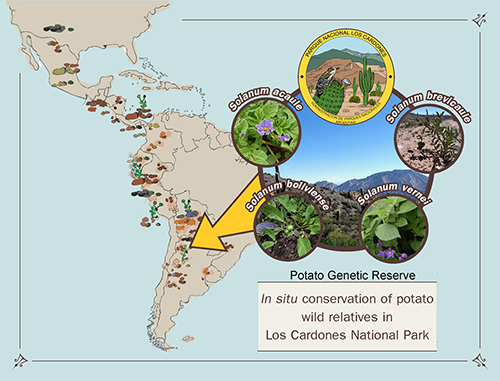Wild potato Genetic Reserves in Protected Areas: prospection notes from Los Cardones National Park, Salta, Argentina
Keywords:
crop wild relatives, in situ conservation, plant genetic resources for food and agriculture, Protected Areas, Solanum acaule, Solanum boliviense, Solanum brevicaule, Solanum verneiAbstract

Wild potato species (WPS) are vital genetic resources to improve the productivity and sustainability of the third most important food crop worldwide. Although in situ conservation of this germplasm has been considered the most appropriate strategy, establishment of Genetic Reserves is still incipient. Northwest Argentina is among the priority regions for establishing WPS Genetic Reserves, whose designation within Protected Areas is accepted as the most efficient approach. In this work, we present results of the prospection and collection of WPS in Los Cardones National Park, a Protected Area with high environmental heterogeneity and diversity of plant communities. Four wild and one cultivated potato species were identified in different physiognomic vegetation units: Solanum acaule, S. brevicaule, S. boliviense, S. vernei and S. tuberosum group Andigenum. In the four WPS, characters of interest for plant breeding have been described. Through the development of environmental education workshops and the monitoring over two consecutive years within a worldwide priority site, we have established a baseline on which in situ conservation will be projected to preserve an essential component of the natural and cultural America's patrimony.
Highlights
-
Northwest Argentina is a priority region to develop in situ conservation programs of potato wild relatives.
-
Los Cardones National Park is a Genetic Reserve in which primary and secondary gene pool of the cultivated potato could be conserved.
-
Solanum acaule, S. boliviense, S. brevicaule and S. vernei were surveyed, monitored and collected in different physiognomic vegetation units within the Los Cardones National Park.
-
A baseline with distribution data and phenological stages of populations of the four wild potato species was established.
-
Communication, education and awareness activities related to the conservation of wild potatoes species and landraces were carried out.

Downloads
Published
Issue
Section
License
Aquellos autores/as que tengan publicaciones con esta revista, aceptan las Políticas Editoriales.


